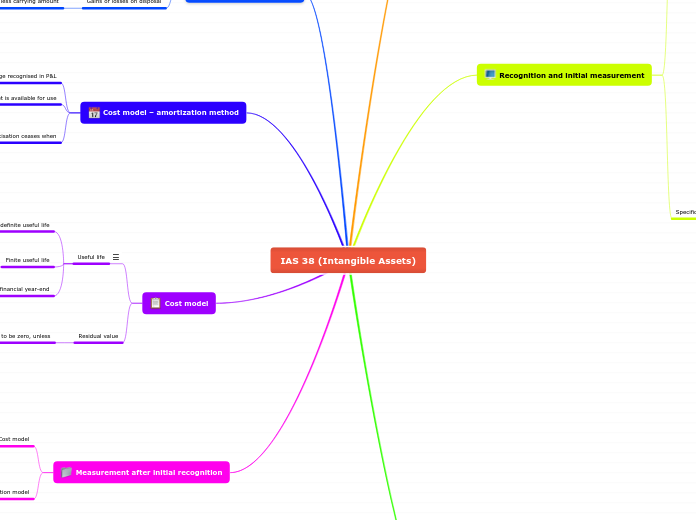IAS 38 (Intangible Assets)
Definition
Examples : ➢ Computer software
➢ Patents
➢ Motion picture films
➢ Import quotas
Aller voir le slide 48 semaine 2
Recognition and initial measurement
An asset meeting the definition of an intangible asset should be recognised when
It is probable that future economic benefits associated with asset will flow to the enterprise and cost of asset can be measured reliably
Specific principles
Acquired in a separate acquisition
Recognition
Probability criterion => always satisfied
Reliable measurement => usually satisfied (particularly when payment is in monetary assets)
Measurement
At cost
Cost components when purchased
− Purchase price, import duties and purchase taxes, directly attributable expenditure of preparing the asset for its use
and less trade discounts & rebates
Expenditures that are not part of the cost of an intangible asset
− Costs of introducing a new product or service (incl. advertising and promotional activities)
− Costs of conducting business in a new location or with a new class of customers (including costs of staff training) and administration and other general overhead costs
Acquisition in a business combination
Recognition
Probability criterion => always satisfied
Reliable measurement => always considered to be satisfied
Measurement
At fair value based on
− Quoted market prices (active market)
− If no active market, use techniques to estimate fair value
• multiples/profitability
• discounted future cash flows...
Internally generated goodwill
Not recognised as an asset (expense to P&L)
Internally generated intangible assets
Expense to P&L
Research expenses
None of intangible asset arising form research (or research phase) should be recognised
All expenditure on research should be expensed when incurred
Examples of research activities :
• Gaining new knowledge
• Search for applications of research findings
• Search for alternatives to materials, products, processes, etc.
• Formulation, design, evaluation and selection of possible alternatives for new or improved materials, products, processes, etc.
Development expenses
Capitalisation of development costs if, and only if
−All these criteria are met :
− technical feasibility
− intention to complete
− ability to use or sell the asset
− probability of future economic benefits
− availability of resources (technical, financial)
− expenditure can be reliably measured
Some remarks
Intangibles acquired in
a business combination
In process R&D to be
recognised as well
The fact that the acquirer has no intention to further use these intangibles is not a reason not to recognize them at fair value
Intention not to use has no
impact on initial fair value
Development expenses
In pharma and life sciences industry it is very rare that development expenses are capitalized (technical feasibility criterion)
In some cases no material further development expenses are to be incurred from the moment all criteria to capitalise were met
IAS 38 requires to expense (passer en charge)
Training costs
Advertising costs
Relocation costs
Start-up costs
Retirements and disposals
Elimination from balance sheet when
Disposed of or no future economic benefits are expected from its use or disposal
Gains or losses on disposal
Proceeds less carrying amount
Cost model – amortization method
Amortisation charge recognised in P&L
Amortisation begins when the asset is available for use
Amortisation ceases when
The asset is classified as held for sale in accordance with IFRS 5 – Non-current Assets held for Sale and Discontinued Operations or the asset is derecognised
Cost model
Useful life
Indefinite useful life
No amortisation, but annual test of impairment according to IAS 36 (Impairment of Assets)
Finite useful life
Allocation of the depreciable amount (= cost – residual value) on a systematic basis over the useful life
Review at the end of each financial year-end
Change in accounting estimate accounted for prospectively
Residual value
Assumed to be zero, unless
Commitment by a third party to purchase or active market and
- Residual value can be determined by reference to that market
− It is probable that such a market will exist at the end of the useful life
Measurement after initial recognition
Cost model
Cost less accumulated amortisation and impairment losses
Revaluation model
Revalued amount less accumulated amortisation and impairment losses
Not further discussed as very rare and only possible for intangibles for which there exists an active market
